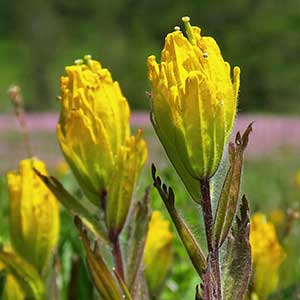Castilleja levisecta
Castilleja hololeuca
golden Indian paintbrush, golden paintbrush
Channel Islands paintbrush, island paintbrush, island white-felted paintbrush, white-felted paintbrush
few to many, erect, ± decumbent or creeping at base, unbranched, sometimes branched, hairs spreading, medium length and long, soft, mixed with short stipitate-glandular ones.
many, erect to spreading, much-branched with many short axillary shoots, proximal stems reaching 1+ cm wide, white-felted, hairs dense, spreading to ± appressed, intertwined, long, soft, slightly branched, obscuring surface.
green to purple or brown-tinged, linear-lanceolate proximally, oblong-ovate or -obovate distally, 0.8–5.2 cm, not fleshy, margins plane, distalmost sometimes ± wavy, involute, 3–7(–11)-lobed, apex obtuse;
lobes erect to ascending, linear to linear-spatulate, very short, toothlike, usually arising from distal 1/3 of blade, apex rounded.
ash gray, leaves of previous year persisting on proximal stem, linear, older leaves sometimes broadly linear, 1–5 cm, not fleshy, margins plane, involute, 0-lobed, apex obtuse;
lobes ascending, linear-lanceolate, apex obtuse to rounded, sometimes acute.
2.5–25 × 1–4 cm;
bracts bright yellow throughout, or proximally greenish, distally bright yellow, sometimes deep yellow-orange, especially with age, oblong, elliptic, or obtuse to ovate, (0–)5–9(–13)-lobed, sometimes wavy-margined;
lobes erect to ascending, oblong, short to medium length, arising above mid length, central lobe apex rounded, lateral ones rounded to acute.
3–16 × 2–4 cm;
bracts pale gray-green throughout, or proximally pale gray-green, distally red or yellow, proximal linear, distal broader, often oblanceolate to obovate, (0–)3-lobed;
lobes spreading, linear to oblong, short to long, arising below mid length, apex rounded to truncate or acute.
straight or slightly curved, 17–28 mm;
tube 12–15 mm;
beak exserted, adaxially green or greenish yellow, 6–8 mm;
abaxial lip yellow or greenish, reduced, not inflated, 2–3 mm, 25–33(–50)% as long as beak;
teeth ascending to erect, yellow, 0.5–1.5 mm.
slightly curved in proximal 1/3, 14–26(–31) mm;
tube 9–17 mm;
abaxial lip not exserted, beak exserted;
beak adaxially green to yellowish, 11–14 mm;
abaxial lip ascending, deep green, reduced, 2–3 mm, less than 33% as long as beak;
teeth reduced to apiculations, deep green, 1–1.5 mm.
distally yellow, 13–22 mm;
abaxial and adaxial clefts 4–9.5 mm, 30–40% of calyx length, deeper than laterals, lateral 2.5–4.5 mm, ca. 25% of calyx length;
lobes linear to narrowly oblong or narrowly lanceolate, apex obtuse, sometimes rounded to acute.
colored as bracts, with conspicuous whitish veins, 14–18(–20) mm;
abaxial and adaxial clefts 5–12 mm, 30–67% of calyx length, deeper than laterals, lateral 0 mm or nearly so, ca. 0% of calyx length;
lobes linear-lanceolate, apex rounded, truncate, or emarginate.
= 24.
Castilleja levisecta
Castilleja hololeuca
Castilleja levisecta is listed as threatened in the United States and endangered in Canada, where it is extremely rare. Most of its grassland habitat has been altered by development in the Puget Trough, and there are historical stations in the metro areas of what are now Victoria, Portland, and Seattle. For several decades, C. levisecta was considered extirpated from Oregon. However, recent reintroduction programs in Oregon and Washington have been very successful at reestablishing this species at several sites in the Willamette Valley. The bright yellow inflorescences often gradually age to a golden yellow color, unique in the genus.
Castilleja levisecta is in the Center for Plant Conservation’s National Collection of Endangered Plants.
(Discussion copyrighted by Flora of North America; reprinted with permission.)
Castilleja hololeuca is endemic to the four major islands of the northern Channel Islands. It is similar to C. lanata, a mostly Mexican species that reaches Arizona, New Mexico, and southwest Texas. However, C. hololeuca appears to be more closely related to C. foliolosa, a species of the California mainland. These three species, and C. galehintoniae G. L. Nesom of Nuevo León, all share a distinctive, thick indument of pale, matted, and often branched hairs on the stems and leaves. Large individuals of C. hololeuca form thick, woody trunks. On Anacapa Island, closest to the mainland, red-flowered forms of C. hololeuca predominate. On Santa Cruz Island, to the west, both red- and yellow-bracted forms are fairly common, usually in separate populations. Further offshore, on San Miguel and Santa Rosa islands, most plants are yellow to, occasionally, peach in coloration. Reports of this species from Santa Barbara and Santa Catalina Islands are referable to other species, mostly C. foliolosa. Populations of C. hololeuca historically declined from grazing by introduced game and livestock species. The plants are recovering well, following removal of the grazing animals, and are now common in many areas, especially on San Miguel Island.
(Discussion copyrighted by Flora of North America; reprinted with permission.)


